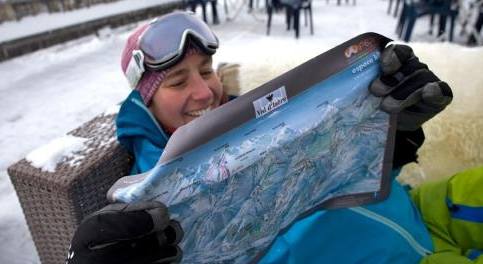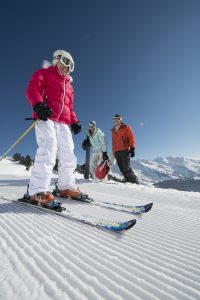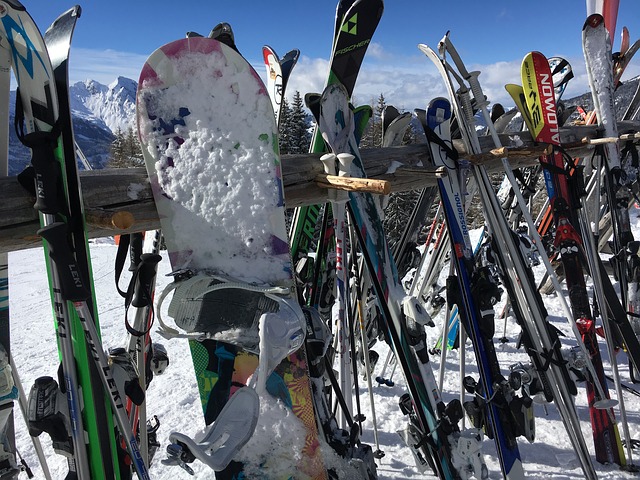
Whether you are visiting Val D’Isere for the first time or you are a returning snowsports enthusiast, you will be seeking those runs that make your heart sing. Just because you have the Val D’Isere piste map doesn’t guarantee that you understand which slopes suit your abilities or the ski experience you came for. Combining experienced insider knowledge about the mountain with a clear understanding of the Val D’Isere piste map will ensure that every day of your ski holiday leaves you with a big grin on your face and never wanting to leave.
Disastrous Days
The first time I took my family on a ski holiday, I did my best to make our time on the piste as enjoyable as possible. Our children learned to ski in the UK before the holiday so that they could safely negotiate most pistes. Thanks to friends who were familiar with the pistes on the Grand Massif, our children had an amazing ski holiday and were confidently able to negotiate green, blue and red runs.
On our second self catering family ski holiday, the early snow melt at Easter forced our tour provider to relocate us to Les Deux Alpes. None of our group knew anything about the piste area apart from looking at the piste map. Despite being with experienced skiers, the children hated the first day and ended up in tears as we skied down icy blue runs that would be classed as steep reds in other resorts. Three of the four children refused to go back up the scary mountain with us for the rest of the week.
My friends and I resorted to putting the children into ski school with instructors who knew the pistes whilst we explored the mountain to work out which runs on the piste map were suitable for us. It spoiled what was an expensive week. It would made such a huge difference having prior knowledge beyond just having a piste map. We decided we would be better prepared for a ski holiday to Val D’Isere.
Using the Val D’Isere Piste Map to Discover Delightful Days on the Snow
You can enjoy Val D’Isere without being particularly adventurous, but beginners and cautious intermediates need to watch out for the variable piste classifications. Although there are plenty of slopes in Val d’Isère that are enjoyed by all, the ski area is best suited to strong intermediates and experts. Even the gradient of the main nursery slope at the bottom of the pistes is challenging for a complete beginner. A blue run at Val D’Isere could easily be classified as a red in another resort, while black really does mean a serious challenge. It really does help to get advice from someone who knows the area.
If you book your ski holiday at a catered ski chalet, the chalet hosts are very familiar with the Val D’Isere piste. They are always on hand to give invaluable insider knowledge and show you where on the Val D’Isere piste map the best places are to ski on the mountain that suits the type of skiing or snowboarding you love. They will explain the best places for all skiing abilities, families and where you can go freestyle. Val D’Isere is excellent for powder and off piste skiing. You will also want to know some great places to eat and enjoy the scenery.
The Val D’Isere Piste Map

You can get the Val D’Isere piste map in a variety of forms:
- Printed Val D’Isere piste map from the resort ski pass office. This paper piste map is handy to keep with you, but usually ends up like a ball of papier mache in your pocket.
- Official Live piste map from Val D’Isere tourist board with piste and lift status and weather.
- Val D’Isere piste map pdf to print or keep on your mobile phone or tablet.
- Val D’Isere piste map jpg image
- The Fatmap App 3D terrain Val D’Isere piste map for IOS, Android and web browsers. Get location based hi-res terrain models with all of the runs and ski lifts shown, along with your GPS location. You can stream route advice crafted by ski experts for free, or download your piste maps and go offline for under £10 per month. See the Val D’Isere piste map in colour coded 3D showing avalanche zones, gradient, altitude and live status of the runs and lifts.
- Wipeout microfiber lens cloth Val D’Isere and Tignes Piste Map is a cloth you can use for cleaning your ski goggles. It has the Val D’Isere piste map printed on one side and the Tignes piste map on the other. It will survive getting wet and won’t get torn like a paper piste map. It makes a great gift.
Equipped with the Val D’Isere piste map and recommendations from dedicated hosts at ski chalets, you have a winning combination that will ensure that you know before you go. You’ll soon be getting off the gondola at the top of the mountain, smiling contentedly to yourself at the impressive view as you start your first informed descent, fully aware of where you are going and what to expect from the pistes at Val D’Isere.
Getting to Know the Val D’Isere Piste Map
 Val d’Isère is one half of what used to be known as the Espace Killy ski area. It is linked to the neighbouring ski resort of Tignes to form a ski area of 300km of pistes, 10,000 hectares of off-piste and 44km of cross country trails. Val D’Isere offers high quality, snow-sure slopes for everyone from complete beginner to adrenalin driven experts. With a ski area three times more than Whistler, the biggest area in North America, its long season stretches from the end of November into the first week of May, and when other resorts are knee deep in slush, Val D’Isere can still offer light, fluffy powder and fresh, crisp groomed runs.
Val d’Isère is one half of what used to be known as the Espace Killy ski area. It is linked to the neighbouring ski resort of Tignes to form a ski area of 300km of pistes, 10,000 hectares of off-piste and 44km of cross country trails. Val D’Isere offers high quality, snow-sure slopes for everyone from complete beginner to adrenalin driven experts. With a ski area three times more than Whistler, the biggest area in North America, its long season stretches from the end of November into the first week of May, and when other resorts are knee deep in slush, Val D’Isere can still offer light, fluffy powder and fresh, crisp groomed runs.
The village is at an altitude of 1,850m, with the top slopes at nearly 3400m beneath the summit of the Pointe du Montet. The top lift in Tignes is on the Grande Motte and reaches 3,456m.
All of the different ski areas at Val D’Isere are extremely well linked. You can work your way through the system of 94 lifts from Le Fornet all the way across to the Tignes village of Les Brevieres, with proper pistes all the way.
The recently added state of the art Solaise gondola has heated seats and wifi, and has increased capacity by 40 per cent, bringing an end to bottlenecks in high-season. At the top of the Solaise piste, a North American-style eatery and a free-to-use picnic area featuring microwaves and vending machines has also been added.
The Val D’Isere Ski Areas
Val D’Isere is a large and complicated ski area, but taking a little time to study the Val D’Isere piste map and getting advice from your chalet host will mean that you understand where the best runs are concentrated for your standard and how to use the lifts and pistes to work out your routes for the day.
The skiing is split into four different areas:
- La Daille;
- Bellevarde;
- Solaise;
- Le Fornet.
All of Val D’Isere’s ski areas have wide, cruising blue runs higher up and more challenging runs for strong skiers lower down. Beginners will find the best slow skiing zones and easy runs at the top of Bellevarde.
From the centre of town, a couple of minutes’ walk takes you on to the Rond Point, a snow-covered open arena where the ski schools meet each morning and lifts rise up the mountains at either end.
The Train Rouge is a reliable and free ski bus that loops around all of the ski lifts up from the valley, as well as Val D’Isere’s satellite villages every three minutes at peak times. During the day it is an integral part of the lift system.
La Daille
La Daille is a hamlet at the eastern end of the valley. You can reach it by the ski bus and then use the lifts and pistes to head towards Tignes. Ride the Funival underground funicular to the top of Bellevarde, which is a great ski area for families just starting out. This is also the starting point for the exhilarating OK men’s downhill course back down to La Daille.
Bellevarde
Bellevarde at 2827m, at the other hand of the Rond Point, is Val D’Isere’s piece de resistance. You can get there in a single trip using the huge Olympique gondola, the Funival from La Daille. or two chairs lifts. The big collection of green runs at the top is perfect for beginners and families. Beginners and intermediates should take the gondola back down the mountain to avoid the very steep and challenging runs down to the resort. La Face is a steep and extremely challenging black run back down, and was the venue for the men’s downhill at the 1992 Albertville Olympics and the 2009 World Championships. It is best skied early in the day before the snow softens and it gets chopped up. Sharp edges on your skis are essential.
The back of Bellevarde is the starting point for a huge area of various pistes that head towards Tignes.
Solaise
Solaise is a network of intermediate runs of varying standard, including the Rhone-Alpes black, the FIS women’s downhill course built for the 2009 Winter Olympics. Anyone who is not a confident intermediate are best advised to return to the valley at the end of the day by either of the two lifts.
Le Fornet
Le Fornet is the bus stop after Le Laisinant. Taking the cable-car from here is the first step on the long journey by gondola and chair up to the Pissaillas Glacier and Val D’Isere’s highest lift beneath the Pointe du Montet. The glacier is open for skiing in June and July during the French summer holidays and winter continues here for 12 months of the year.
When the resort is at its busiest, those familiar with Val D’Isere head here to catch the Laisinant Express chair. From the top you can connect to runs in the direction of Solaise or with Le Fornet.
If you have the ready cash then Bonneval is a great trip from Le Fornet. You will need a guide, good weather and a helicopter to get back to avoid the three hour taxi ride.
Tignes
The seamlessly linked resort of Tignes also has a huge amount to offer. The off piste terrain is enormous and taking a guide is the only way to really do it justice.
The view from the top of La Grande Motte in Tignes is breathtaking. Another great viewpoint is the top of the Grand Pre chairlift, from where you can enjoy spectacular views of the Vanoise National Park. You will often be able to watch parapenting and speed riders challenging themselves off-piste.
The Best Runs in Val D’Isere for Beginners and Families
 Although there is a lot of very challenging terrain in Val D’Isere, there are places where you can learn to ski. This is best done in a ski school where the instructors know the mountain.
Although there is a lot of very challenging terrain in Val D’Isere, there are places where you can learn to ski. This is best done in a ski school where the instructors know the mountain.
If you are just starting out and developing your skills, the main nursery slope in the village centre has a free chair lift. It also has several handy restaurants with sun terraces for parents to sit and watch while first turns are being achieved. Watch out for the top of the nursery slope as it is rather steep for beginners.
The Madeleine area on the Solaise can be accessed by either the Solaise Express chair or Solaise Gondola. The run on Madelaine is a little steep for a green but very wide and has some of the best mountain restaurants for lunch in the sun. Madelaine is serviced by a giant moving carpet lift, which is really easy for beginners to use.
Bellevarde is the best area for beginners, with a larger selection of green runs and can be reached either via the Oymipique cable car from the centre of the village or via the Funival funicular train from La Daile. There is a long green run that goes from the top of Bellevarde down through trees to La Daille at the bottom. Although classified as a green route down, ski with care. It is probably the world’s most difficult green, but you can get down using chair lifts or the bubble lift
Like Les Deux Alpes, the interpretation of colour grading at Val D’Isere is different to elsewhere: for green read blue, for blue read red, for red read black, for black, well hold onto your lunch.
Beginners and intermediates should seriously think about taking the lift down at the end of the day. The runs home from Solaise, Bellevarde and Fornet are all very challenging and injuries frequently happen on the “last run.” It is much better returning to your ski chalet having had a wonderful day on the snow rather than being a quivering wreck from the steep icy slopes and speed demons on the home runs.
The Best Runs in Val D’Isere for Intermediates
Taking the Olympique gondola up Bellevarde, the Fontaine Froide is a relatively easy red. From the bottom you can take the blue Santons down, taking care not to stray onto the adjacent black.
Another good area of the piste in Val D’Isere for intermediate skiers is the Solaise. It has a good network of delightful blue runs, with fast undulating terrain and amazing views. You can easily spend a few hours on these runs because they are wide and have some speed sections. Wide slopes are ideal for snowboarders who are terrified of flatlining straight downhill. Glorious for carving and wide sweeping turns.
From the top of Solaise you can take the up and over Leissieres chairlift to the Le Fornet side where you can ski from the top of the glacier right back to the valley floor on using the blues and reds.
Bellevarde is where most intermediate skiers head simply because it links to the runs in Tignes and offers lots of great routes to explore.
Val D’Isere Freestyle Ski Areas and Terrain Parks
The snowpark at Bellevarde under the Mont Blanc chairlift has jumps of varying sizes, as well as boxes and rails – so it’s much like a slopestyle course. There is also a giant airbag, great for people who want to practise spinning or going upside down. The snowpark in Tignes, where Olympic snowboarder Jenny Jones practised whilst a chalet maid, is home to one of the best halfpipes in Europe. There is also the natural terrain park run off the Palafour lift which is packed with jumps and bowls.
The Oakley Valpark boasts a good range of rails and kickers for all standards, and is located between Bellevarde and La Daille sector at the foot of the Marmottes chair. It is adjacent to Stade de Slalom, a permanent downhill race course where you can run gates against the clock. You can reach it from the Funival and Olympique or by the Mont Blanc chair.
The Best Ski Runs in Val D’Isere for Experts
Experts love the famous “La Face.” This steep and often mogulled run drops from the top of Bellevarde back down to the centre of the resort. Although there are a limited number of Black runs shown on the Val D’Isere piste map, some runs have been converted to “natural snow runs,” which means they are not groomed but are patrolled and cleared of any avalanche risks.
The most challenging run, La Forêt, cuts through the trees and is ideal for those who love moguls.
The black Epaule du Charvet is a run that is so steep that it can only be groomed by a piste-basher attached to a cable and winch.
Val d’Isere has one of the best lift served off piste ski areas in the world. Do not venture off piste without a qualified guide.
One of the most popular off piste routes is a traverse from above La Fornet in the Pays Desert. This open off piste field on the Glacier Du Pissaillas eventually drops to the Pays Desert drag lift. Make sure you don’t over shoot this drag lift because it’s a long walk back.
Something for Everyone
Whether you have a family, group of friends or are skiing with business colleagues, understanding the Val D’Isere piste map will allow you to make the most of your time on the piste. With something for everyone, make the most of your ski chalet host and you will want to return again and again.
